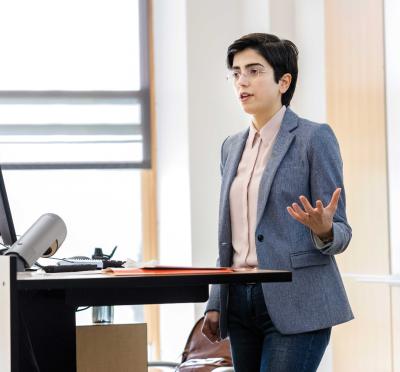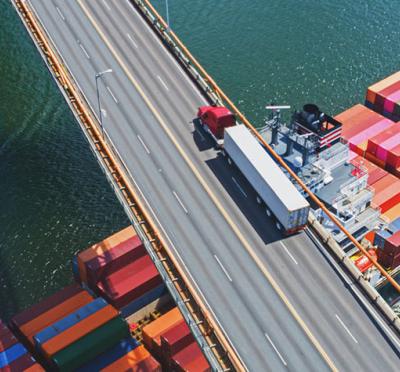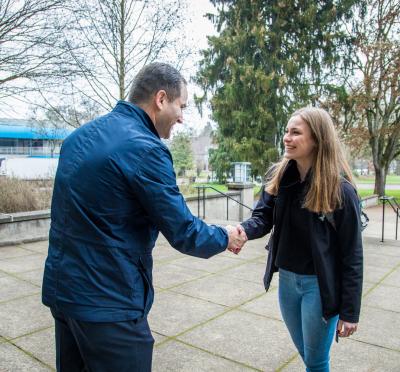
A whopping 5% to 8% of the carbon released into the world’s atmosphere comes from the production of cement, a key component of concrete. At Oregon State University, researchers are developing numerous ways to reduce that load and related climate impacts.
“Cement accounts for such a high level of carbon emissions because it is used extensively throughout the world,” said Jason Weiss, the Miles Lowell and Margaret Watt Edwards Distinguished Chair in Engineering. “We use 10 times more concrete than any other material, and it is becoming increasingly urgent that we reduce the carbon footprint of infrastructure materials.”
One project, led by Burkan Isgor, professor of infrastructure materials, aimed at reducing the release of carbon from infrastructure such as roads, bridges, and buildings is the development of computer models to help cement and concrete makers understand the impact of cement’s constituent materials on concrete’s properties at a fundamental level. “It’s exciting to start with the elemental composition of cement-making materials and predict the properties of concrete with accurate physics-based models,” Weiss said.
Industry peers recognized the value of this work when Keshav Bharadwaj, a graduate student advised by Weiss and Isgor, received the Gigatec best paper award and top prize for a poster presentation at the prestigious Gordon Research Conference.
Among the many industry partners seeking to tap into Oregon State’s fundamental knowledge of cement and concrete is Solidia, a startup company that has developed a cement that captures carbon from the atmosphere. The company is working with Weiss and Steve Reese, associate professor of nuclear science and engineering, to test its material.
Solidia’s technology uses a process called carbonation curing, in which a specialized cement is exposed to carbon dioxide. The resulting reaction strengthens the concrete in a matter of hours, sequestering carbon in the process. In addition to reducing emissions, it’s quicker and uses less water and energy than conventional techniques.
Since the fundamentals of Solidia’s cement are different from those of conventional cement, testing samples requires new processes. Weiss and Reese are using neutron radiography to conduct state-of-the-art measurements on how the carbonation reaction occurs throughout the thickness of the Solidia samples.
“We’ve learned a lot, and it’s a challenging field,” Weiss said. “We have to think differently and do this from the ground up because the rules of thumb have changed and there really aren’t standardized tests. This a very different, but very exciting, technology.”
Over the years, other research on reducing carbon emissions led by Weiss has been adopted into national codes and standards, protecting public health, safety, and the environment.
The Portland Cement Association and the American Association of State Highway and Transportation Officials Code adopted new standards on the use of Portland-Limestone cement, based on research by Weiss and his colleagues, resulting in a 5% to 15% reduction of carbon emissions.
“Much of my work for Midwest departments of transportation showed that if PLC replaced ordinary Portland cement and becomes widely adopted, it would be the equivalent of taking a million cars off the road from a CO2 perspective,” Weiss said. “It’s been gratifying to see the use of these materials increasing. We are excited to be working with other DOTs now to further build on these findings.”
In another related project, Isgor and his team recently worked with the Electric Power Research Institute to examine the use of fly ash, a byproduct of burning coal, as a replacement for some of the cement clinker — small pieces of limestone, clay, and other materials formed in the manufacturing of cement, which are ground into a powder to serve as a binder.
“We’ve had great results, both computationally and physically, that demonstrate we can use more of that material, and thereby reduce CO2 content,” Weiss said.
Weiss and his colleagues are also collaborating with the U.S. Forest Service to collect cellulose nanocrystals, harvested from forest undergrowth, for use as a component of concrete.
“This process not only helps clean up undergrowth by removing material that easily burns, but the cellulose nanocrystals also enhance the performance of concrete,” Weiss said. “It effectively supercharges the cement, causing it to react more, and in some mixtures, we have seen a change in structure that leads to an increase in the tensile strength of the concrete up to 30%.”
Weiss and his colleagues worked with industry partners to verify and test these new materials.
“In my 27 years in the business, I have seen incredible technological advancements in ready-mixed concrete,” said Brian Gray (’93 B.S., Civil Engineering), president, NW Region, Knife River Corporation. “From mix designs to plants to trucks, things we couldn’t imagine even 10 years ago are commonplace today. It’s our pleasure to work with Oregon State University and others to explore innovations that will help us continue to reduce carbon in our building materials.”
“The opportunity to collaborate with academia creates a win-win for both participants, but more importantly, has a profound impact on the future of our environment, means and methods, material use, and the built environment,” said Tim Sissel (’97 B.S., Construction Engineering Management) senior project manager, Fortis Construction.
The research on cellulose nanocrystals is now moving from the lab to the field. Full-scale commercial applications in South Carolina and Wisconsin and a bridge in Siskiyou County,
California, will use the material.
“At the core of all this, we want to produce better, more sustainable, and longer-lasting concrete,” Weiss said. “Consider the life of a bridge. With a minor change up front, we have shown that we can replace that bridge every 75 years, not every 30 years, and that cuts down the carbon footprint by at least half. Our goal is not to do research that sits in a book on a shelf. We want to impact standards, specifications, and construction practices that move the profession forward.”



